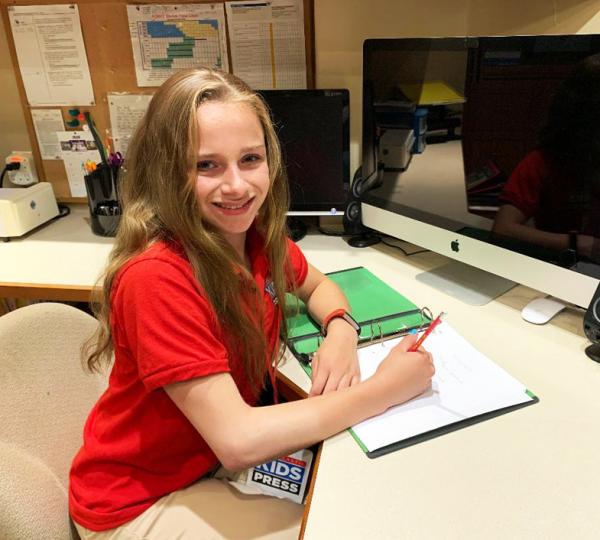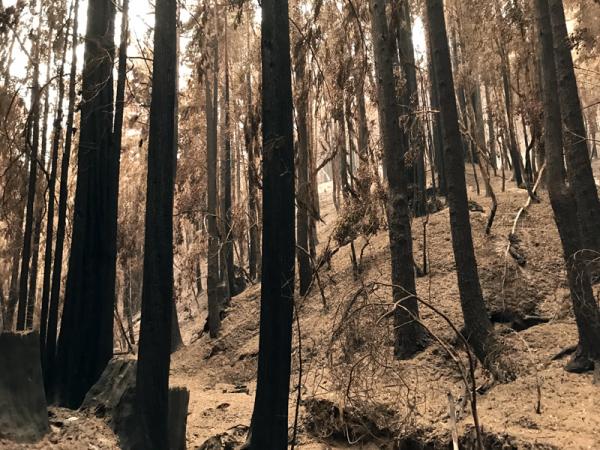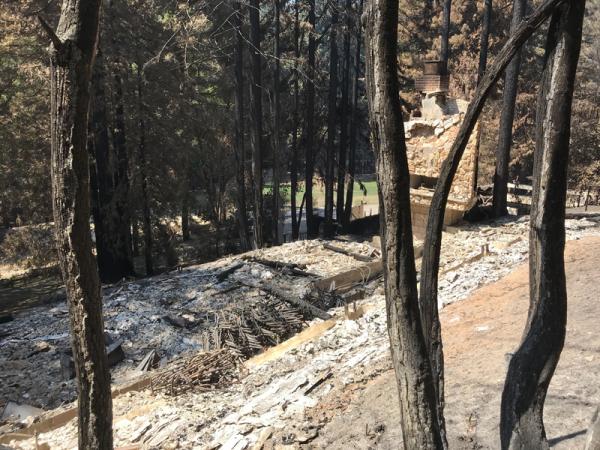KID REPORTERS’ NOTEBOOK
Hope Buried in the Ashes


A series of lightning strikes helped spark intense wildfires in California this summer.
In the early morning hours of August 16, a rare dry lightning storm sparked a performance in the sky that caught the attention of many residents of Santa Cruz, California. Little did they know that beyond the astonishing show, the lightning actually sparked more than 26 fires. One of the fires was named the CZU Lightning Complex fire of San Mateo and Santa Cruz counties. Active for 37 days, it destroyed more than 86,500 acres and nearly 1,500 structures.
“With fires established all throughout California,” said Scott Kenney, a captain specialist for Cal Fire, “resources throughout the region and state were scarce.”
Limited resources and the steep terrain dominated by century-old redwood forests made access to the area almost impossible for the firefighters. At the start, Cal Fire’s main focus was to evacuate everyone in the fire’s path. “Multiple fire stations and agencies were [also] threatened or impacted by the CZU Lightning Complex,” Kenney said. Our own local firefighters had to be evacuated from their fire stations and homes.
When the fire began, it raged through Big Basin Redwoods State Park, California’s oldest state park. The historic headquarters visited by 250,000 tourists each year is gone, along with the park’s campground.
The damage to the trees is the biggest concern. Redwood roots can stay burning for up to a year.
“Naturally, redwood trees are relatively resistant to fires,” Kenney observed. “But there are portions of the CZU Lightning Complex that burned with such intensity that the redwood trees will have little chance for recovery.”

The sign at the entrance of Camp Hammer
THE ROAD TO CAMP HAMMER
A few miles down the road from Big Basin is Camp Hammer, a 100-acre Christian camp owned by Twin Lakes Church. It is well-known locally for its week-long summer camps, which welcome fourth- through twelfth-grade campers.
The towering redwood trees, delicious food, fun rides, and supportive staff make this camp unique. Within the camp’s trees are many adventurous rides including a zip line, rope swing, and climbing wall. There’s even a trapeze to help campers bond with each other.
The camp has been a special place for thousands of people over the past 55 years. “People of all ages formed deep friendships that last to this day,” said Mark Spurlock, a pastor at Twin Lakes Church. “Whether as a camper or staff member—the camp has had such a deep impact on people’s lives.”

During the pandemic, Ella has reported from her home in California.
EXTENSIVE DAMAGE
As the fire approached, all 18 year-round residents of Camp Hammer evacuated their homes in a hurry. After grabbing a few things, they drove down the mountain, thinking that they would be back soon.
Later that night, the fire destroyed 30 structures at the camp, leaving only three cabins, two sheds, and the field stage. With little remaining of the familiar sites, the staff returned to see the damage.
“What the pictures can’t convey is the scope of it all,” Spurlock said. “When you’re walking the property, there’s a deep sense of how extensive the damage is.”
A portion of the chimney and metal-framed chairs are about all that remains of the camp’s large dining hall. Campers had typically gathered in the building for meals and the famous Camp Hammer chocolate chip cookies.
“To see what’s left of the chimney where the dining hall was, it looks like a bomb was dropped on it,” Spurlock said. “It’s hard to take in when you know a building so well and then you’re staring at nothing but ashes and debris.”
Can the camp be rebuilt? “We all hope and pray we can eventually rebuild Camp Hammer,” Spurlock said. “But it will take several years. And if we do, we’ll make it even better than before.”

The redwood trees near the camp took a hard hit, and the ground was covered with ash.
A PERSONAL STORY
Eric and Sarah Swanson-Dexel, the directors of Camp Hammer, made their home there. They raised their three daughters at the camp and have dedicated their lives to serving the community. To the campers, they are known affectionately as Mossi and Shasta.
Due to the pandemic, weekly summer camps had not been possible this year. Instead, Mossi, Sarah, and a limited staff hosted family day camps and outdoor movie nights on the weekends. Just a week before the fire, my family and I spent a day up at the camp, enjoying the beautiful surroundings.
Mossi later recalled his experiences leading up to the fire. On the night of August 18, he said, “I drove one-and-a-half miles to the Big Basin State Park headquarters and asked a ranger if we were still safe. He assured me that it was just ‘poor air quality.’ Even the ranger had no idea that we all would be evacuating, literally minutes later. We grabbed what we could, which wasn’t much, and drove our cars down the mountain.”
With the year-round staff safely evacuated, there was a “looming wonder of the unknown” for more than a day, Mossi said. When news broke about the destruction of the camp, residents, staff, church members, and community residents were stunned and heartbroken.

The fire tore through the camp’s dining hall, leaving only the chimney base and charred remains.
“PART OF SOMETHING BIGGER”
With their home and jobs lost, “going back up to camp was sobering,” Mossi said. “I had no thoughts. I was numb. At times, I lost my breath seeing the weight of devastation. I ached at a level I haven’t felt before.”
Faith has helped not only Mossi, but also the entire Swanson-Dexel family, persevere. “I have learned that you have to grab from down deep inside to that small mustard seed of faith and believe with every ounce of your person that it can move a mountain,” Mossi said. “It’s that small amount that keeps me going and holding on that hope does not disappoint.”
Former staffers and members of the church have shown their support with kind acts and messages of encouragement. The Swanson-Dexel family is taking each day as it comes, but without the camp at the center of their lives, the journey has been difficult.
“I miss home,” Mossi said. “I miss being part of something bigger than myself. I miss feeling the passion and purpose of serving people with my whole heart. I miss the campers and families. I miss the sounds at camp. I miss what was so much of my life for the past 17 years.”
